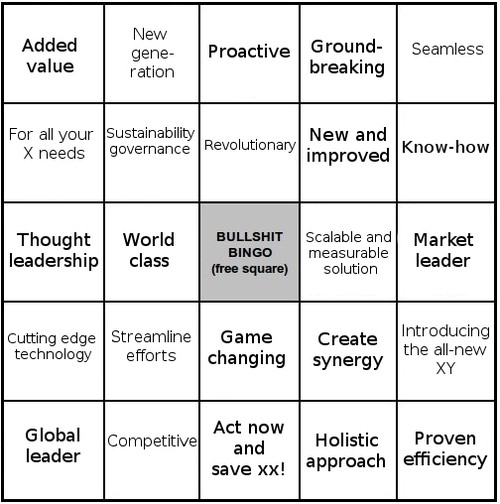Some points about the language of marketing materials
Getting bored with the repeated marketing nonsense when looking through similar press releases and marketing copies? Try the all-new Marketing Bullshit Bingo by translatorsanonymous.
I guess you know the principle. Whenever you see one of the buzzwords on your table, check it off and call out “Bingo!”
As soon as you have a row of five in any direction, you can stand up and shout “BULLSHIT!!!” The work involved in creating the text in front of you (including yours if you are in the supply chain) is pretty much a waste of time.
If this Bingo version does not blind you, feel free to make your own ‘industry-specific’ variant.
You can use:
- advanced
- high-performance
- full-featured
- scalable
- integrated
- optimize
- leading edge
Please do not forget to include:
- productivity
- enable
- robust
- leverage
And be sure to add ‘innovative’ and ‘original’. Most companies and most products claim to be innovative. I guess most are not.
Translating the same ready-made phrases again and again, I keep wondering why they do it. Why are they investing in rubbish wasting money for writing, translation, publication, analyzing feedback (if any)?
2
They speak about the increasing popularity of plain language and clear writing. But nothing changes in the language of marketing materials and press releases. It is much easier to offer a new piece of ‘value-added’ and ‘industry transforming’ stuff instead of presenting facts and being specific.
Building a connection with your prospects is far better than simply offering them the information. But can we speak about a connection if the company handles its press releases as disposable messages targeted only at media editors? There is a strong need to understand how your materials can be meaningful and helpful to your target audience.
Steve Jobs once said: “Simple can be harder than complex: You have to work hard to get your thinking clean to make it simple. But it’s worth it in the end because once you get there, you can move mountains.”
Killing buzzwords forces you to speak human-to-human, to be simple in a fresh way and to become more flexible. All bad marketing copies are alike. Every good marketing copy is good in its own way. If you seek to be heard, you should think out of the box.
3
If your marketing materials aren’t translated, international markets assume that your company cannot afford it. But when translated, buzzwords become even more hollow and meaningless. Translators do have a couple of tricks to avoid it, but in some cases even creative translation is helpless.
We lose trust from our readers when we use the same clichès and jargon again and again. These words are too general and vague to create a feeling of something worthy. And your local dealers are perfectly aware of the fact.
The Russian written language is sensitive to repetitions and clichés. You need a very experienced translator to transcreate buzzwords into something more meaningful for your target audience. If not, too much of the work is pointless.
The audience does not read buzzwords. They are being scanned and ignored. And if the company’s marketing copy is buzzwords all along, you can be sure it will be ignored, too. Even a perfect translator won’t help. Garbage in, garbage out.
From press releases and brochures to open days and exhibition booths, be more flexible and talk to your customers instead of announcing ‘innovations’ with ‘enhanced interoperability’. Stop recycling the same phrases and ideas. Especially if you are trying to grow your presence in countries with languages other than English.
Useful Resources:
Organisations
Clarity International
http://www.plainlanguage.gov
http://www.plainlanguage.com
Plain English Foundation
Center for Plain Language
Plain English Campaign
Plain Language Association International
Materials and Publications
A Plain English Handbook. How to create clear SEC disclosure documents
The Plain Writing Act of 2010: Lessons for Industry
Plain English, Chris Mitchell
Free guides at Plain English Campaign





